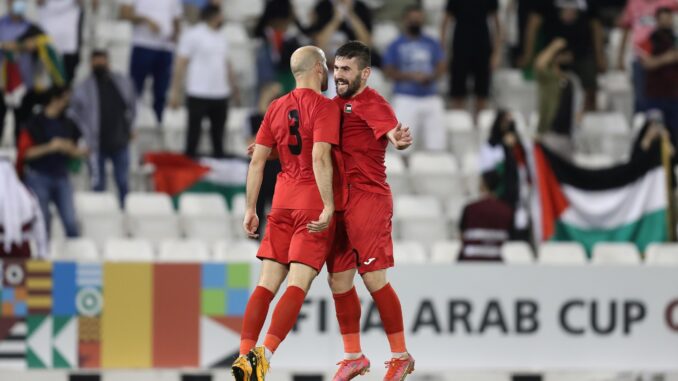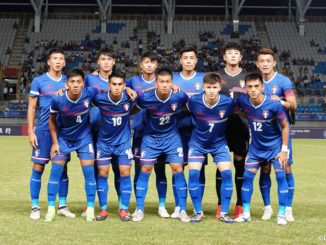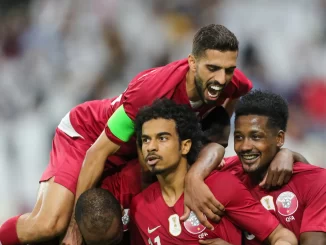
While the footballing world’s attention has been cast elsewhere this last week, Qatar played host to part one of their preparatory hosting period ahead of the World Cup, as the rebranded FIFA Arab Cup settled its final lineup for the tournament proper later this year.
While the initial proceedings offered much more than many were expecting from five one-off playoff matches featuring mid-to-lower ranked Asian and African sides, the tournament’s inception into the FIFA calendar remains an enigma to most outsiders.
With the final tournament now less than six months away, what did the last week of preliminaries tell us about the upcoming Arab Cup, FIFA’s expectations for the tournament and the perception of Qatar, 18 months out from an infamous World Cup?
Amidst a global pandemic, few news stories in world football really surprised anyone; but Gianni Infantino’s announcement at the end of 2020 that FIFA would arrange a pan-Arab Cup as the 2022 FIFA World Cup precursor was indeed a head scratcher.
FIFA had already announced back in 2019, crucially in a pre-COVID world, the dissolution of the FIFA Confederations Cup. After a quarter of a century of mini-World Cups aimed to prepare continental champions and forthcoming hosts for the tournament proper, the prep event to the main stage had significantly lost its momentum in the last decade.
Alongside the now infamous challenge from the European Super League breakaway (how did that all go again?) and an ever-dwindling interest in FIFA’s initial foray into domestic football, FIFA instead replenished the Confederations Cup sized hole with a revamped and expanded Club World Cup to seek the dollar that a greater domestic focused interest brought.
The irony of China, a country still to date unsure of itself in a global sporting arena alongside COVID, acquiring hosting rights for the first such events in the middle of a pandemic won’t be lost on too many, but aside from the logistical question marks, the deferral of last summer’s Euros and Copa America tournaments alone, justifiably shelved FIFA’s plans to roll out their new Club World Cup expansion as intended.
It did leave the growing sideshow, once the focus of the world’s scrutiny, Qatar, out on a limb, a year out from hosting the big thing.
Qatar can hardly be criticised for not being ready however; stadiums are on track, whilst also demonstrating their capability for hosting in a bubble environment (which could yet prove handy next year) stepping in for the latter rounds of the AFC Champions League last year. A test run wasn’t exactly as necessary as it had been in the past.
The trouble for Qatar, however, has always been external perceptions and relations over logistics. As Europe started their “Road to Qatar” back in March, public demonstrations from Norway and Germany reminded FIFA, if they ever needed it, that Qatar’s image in the West remains firmly in the gutter.
Closer to home, the diplomatic spat between themselves and the Saudi Arabia-UAE led coalition didn’t help perceptions either. While publically the feud has been patched up, a number of leaks continue to surface where mass media outlets are still being persuaded to tarnish Qatar and in particular their World Cup hosting.
Seeing himself as a justifiable political peacemaker in his role as FIFA president, Gianni Infantino, set about bringing together the Arab world by formulating an off-the-cuff rebranded FIFA Arab Cup.
In his statement late last year he promised that, “through football, this tournament will unite over 450 million people from across the region.” A bold claim to quickly settle one of the most diverse and volatile regions on the planet, but for anyone who has a track record of uniting North and South Korea (as he clearly did back in 2019), this would be another walk in the park…
The Arab Cup, in it’s pre-FIFA days, was as speculative as it’s modern transformation; a significant history of 60 years, but of late inconspicuous, with only one tournament in the last two decades.
Ran predominantly by the Union of Arab Football Associations, an organisation unrecognised by FIFA, the tournament’s inconsistency aside, it provided numerous successful and regionally well regarded one-off tournaments.
Given the rich culture of the region, especially considering the fierce rivalries, it does generate the sort of attention FIFA desires, if not from the right location.
It’s difficult to assess the last week’s worth of action against their expectations; for one, these were mere preliminaries, and two, it clashes with continental showpieces in both Europe and South America.
Yet, it’s also difficult to envisage a sudden upsurge in attention even come the final tournament in November, given the likely depleted squads on show and it’s problematic scheduling falling outside an official international window.
The matches this week did, however, offer a glimpse of what we could expect from Qatar 2021, and going forward into 2022. Crowds were variable, but the size of immigrant communities that came out to support the likes of Sudan, Yemen, Oman and others, showed how much the excitement, even at this early stage, has spilt over into the stands.
On the pitch, footballing quality was high, with intensities matching such raised levels. With most matches pitting African and Asian sides against one another it was an interesting watch for neutral fans, a mere week on from continental World Cup qualifiers; demonstrating in particular the strides being made in Asia, Palestine and Bahrain being the stand out performers from the week.
It also gave an opportunity to paint a picture of what future tournaments may feel like; official FIFA broadcasts at times made it feel “too good to be true” with inflated atmosphere audio, positive world feed commentary on FIFA’s YouTube channel and almost choreographed stadium attendances (COVID compliant in addition, a far cry from the current international tournaments out west).
While temperature levels remain a sore point amongst their critics; organisers again demonstrated their air-conditioning prowess, reducing stadium temperatures down from an evening temperature of 35°C to a more comfortable 27°C; facilitated by the growingly iconic pitchside portholes.
The added advantage that cooler evening kicks off benefit Western television audiences and that both future tournaments will be played in the winter, organisers are starting to win the climate battle if not the political one.
Logistical ground is being made up also, alongside slow but positive welfare reforms, but the tournament remains an afterthought in global terms, especially so if the likes of North Africa heavyweights Algeria, Morocco and Tunisia are unable to call on their leading European lights later in the year.
In that case, hiding in plain sight, while forging stronger home ties (as the last Gulf Cup also proved), FIFA’s art for misdirection may have expertly moved the spotlight off Qatar for now.
For the teams themselves, the Arab Cup offers a silverware opportunity; the likes of Saudi Arabia, UAE and hosts Qatar will no doubt start as favourites, having full squads to pick from, as they dovetail their own World Cup qualification campaigns around it.
For Qatar further pressure will mount to replicate some of their Asian Cup success of 2019, which they’ve found difficult to replicate ever since.
This next month, a trip to the United States for the Gold Cup provides another opportunity to impress on the global stage. Following on from a solid start to their affixed presence in European World Cup qualification, dare Asian fans dream that they can go deep into contention for another continental gold?
For the Arab Cup, however, the stage is set. While expectations and intentions are thoroughly up for debate from most sides, the tangible footballing product proved worthy of note.
The last week of preliminaries has provided a strong contrast from the concurrent football the Western hemisphere are enjoying at present, yet no less thrilling or passionate.
With the tournament phase primed for a December climax, FIFA and Qatar will secretly be quite happy to keep this very unique tournament an unheralded regional jewel for the time being.
Photo: FIFA.com




